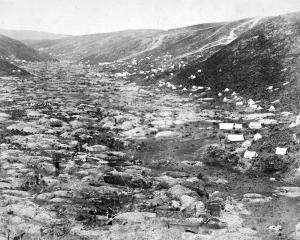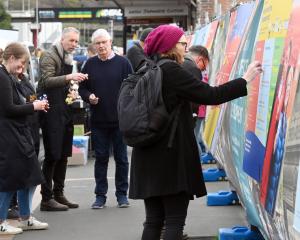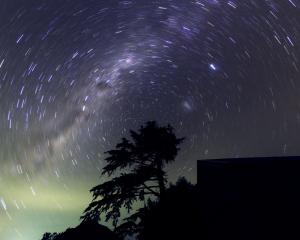Now in his 80s, Emeritus Prof Sir Alan Mark is still making headlines championing the environment. Bruce Munro talks to Sir Alan about being a witness and an unrelenting participant in more than half a century's significant struggles for nature conservation.
The telephone jangles, sudden and effusive.
Sir Alan Mark cuts short the explanation of his honorary doctorate with an ''Excuse me'' and twists on his chair to grab the telephone receiver.
His turned back affords the opportunity to cast a long look around the University of Otago emeritus professor of botany's office.
Tucked away in a converted bungalow on the northwest edge of the Dunedin campus, illuminated by natural light from a solitary window, the room has an air of historic import.
A desk and computer, orderly shelves of books and tidy stacks of bulging folders and papers populate the space.
But around, between, above and below this furniture, covering virtually all available wall space, dangling off the lower edges of shelves, even hanging from the roof, are photos, awards, newspaper clippings, posters, political cartoons, bumper stickers and more photos.
Behind the door, at lintel height, a ''Save Manapouri'' sign in bold black ink is pinned to the wall.
Near it is an altered Forestry Service logo and the words ''Don't beat about the bush. Just stop logging''.
''Save Fiordland: No monorail, no tunnel'' a red sticker shouts back from across the room.
Between them, and below framed awards, is a photograph of Sir Alan standing with Sir Edmund Hillary.
Not far away, a black-and-white photo of global botanist David Bellamy and Sir Alan, taken in the mid-1980s in the Waitutu Forest, southeast Fiordland.
Tellingly, there are two posters of ever-dusty cartoon character Pigpen with the words, ''To be an ecologist, you've got to stir things up a little''.
Above the computer is a Grahame Sydney-esque photograph of Sir Alan's beloved golden landscape - burnished tussock leading the eye towards the molar-toothed Lammerlaws beneath a deep blue sky; to its right, a cartoon commentary on government mining aspirations, depicting MP Gerry Brownlee with his head stuck ostrich-like in the ground, is taped to the wall; nearby, a photograph of Sir Alan and his wife Lady Pat Mark during last November's presentation of the Wise Response petition at Parliament ... myriad manifest memories of a lifetime of research, advocacy, conflicts and accolades that have absorbed this man and shaped New Zealand.
His wife has broken the base of her tibia (shinbone), Sir Alan explains when he gets off the phone.
''It's not too bad. But it's one of the hazards of the geriatric phase of life,'' he says with a hearty chuckle.
Indeed.
Sir Alan is 83.
He and Lady Mark have been married 58 years.
They have four children and several grandchildren.
He has had a long, active and distinguished career in ecology research and advocacy.
Yet, despite now being a semi-retired emeritus professor ''setting my own priorities'', it appears he has scarcely slowed at all.
He is still making headlines.
Last week, the front page of the Otago Daily Times detailed Sir Alan's disappointment at the Government's rejection of a petition he had helped organise calling for a formal assessment of risks posed by interconnected climatic, economic and social issues.
And Otago University Press has just published a book he has written, Standing My Ground: A voice for nature conservation.
It is, as Sir Geoffrey Palmer describes in the foreword, ''a book like no other I have read'' telling the story of ''a man and a career New Zealanders should celebrate''.
Not an autobiography or a textbook, nor a treatise on conservation, Standing My Ground is a chronicle of how Sir Mark has done exactly that, remaining true to his research and his convictions no matter the opposition.
As a consequence, because he has been a recognised expert who has stood in the gap for so long, the book is a unique first-hand account of seminal events in the decades-long fight for New Zealand's progressively valued, increasingly bankable, but still threatened ''clean, green'' natural world.
In the late 1950s, Sir Alan was involved in gathering the first climate records from Central Otago mountains.
During the 1960s and 1970s, his research transformed the understanding and appreciation of tussock grasslands as an integral and important element of New Zealand's distinctive ecosystem and landscape.
His leading role in the fight to preserve Lakes Te Anau and Manapouri put him at the centre of New Zealand's budding environmental awareness in the early 1970s.
During the 1980s and 1990s, he served on a dozen quasi-autonomous non-governmental organisations (quangos) whose achievements included establishing forest reserves throughout New Zealand, creating two new national parks, elevating the value of wetlands, producing the first conservation strategy for Otago and major steps towards sustainable management of the country's fiords.
During Sir Mark's watch as president of the Royal Forest and Bird Protection Society of New Zealand, and at the society's urging, government-owned land in southwest New Zealand, stretching from Mt Cook National Park to the southern edge of Fiordland, was granted conservation status.
In 1991, the 2.6 million hectare Te Wahipounamu was recognised as a Unesco World Heritage site.
His fight to save Manapouri - for which Sir Alan is perhaps best known - actually began with a commission by then government science agency DSIR to conduct a detailed environmental assessment of Manapouri's lakeshore.
In the book, he says it was clear the purpose of the work was simply to record what would be lost when the lake level was ''inevitably'' raised for hydro-electric power generation to supply the Tiwai Point aluminium smelter.
Talking in his office, all these years later, he says the state engineers involved seemed to have no concern for the environment.
''I didn't know what I was letting myself in for when we accepted it [the survey job], but it soon became obvious we were dealing with a group of government engineers who basically, in the words of Norman Kirk, were playing God,'' Sir Alan recalls.
''[One person] said if they raised the lakes they would be improving on nature ... It was a national park but they didn't attach any particular value to it. It was basically just there for the taking.
"They certainly got a major awakening when they realised the public was pretty concerned and put such value on those areas.''
It became a key issue in the 1972 general election.
The newly elected Labour Government then took the unusual step of appointing former Save Manapouri campaigners, including Sir Alan, as guardians of Lakes Manapouri and Te Anau, to advise the Government on how to manage the lakes.
Explaining the science behind the arguments for protecting the environment became a theme for Sir Alan.
''My greatest satisfaction,'' he says, ''has been being able to convey to the wider public the value of natural areas and the significance of integrating ecological principles with the sustainable use of our natural resources.''
• From the same campaign, he learned a related and vital lesson, one that saw him joining Forest and Bird in the late-1970s and which continues to guide his efforts today.
''The Manapouri campaign demonstrated how essential it is to have public support in order to sway the political system.''
Scientists might have all the facts and arguments, but on their own they can struggle to gain traction, he says.
''So, unless you can educate the public and get them onside, the politicians can afford to ignore it ... But they will listen when they feel there is a majority view.''
Standing My Ground was not, to begin with, for publication.
Double hip surgery in 2003, however, meant some forced downtime.
''So, I decided I would commit a few thoughts to my little field cassettes.
''It was just a personal record really. My own record of my own activities.''
The botany department secretary typed them up, and ''I've been editing them and adding to them since then''.
A decade later, Otago University Press said it would publish the memoir.
Because of its origins, or perhaps because its author prefers to deal in facts, it is a book often bereft of detail about motivations and passions.
The research findings, the disputes, the individuals, the battles won and lost are largely all accounted for.
But who Sir Alan is as a man, where the spark came from and what continues to fire his determination has to be read mostly between the lines.
The first page includes details of Sir Alan, as a boy, making his daily 2km walk to Mornington School, Dunedin, past Kaikorai Valley's Roslyn Woollen Mills, which discharged its dyes into Kaikorai Stream.
The book does not say what impression it made on the primary school pupil. Sir Alan, sitting in his office, owns that it was significant.
''The stream was virtually lifeless. You couldn't play in it.
''I thought it was really bad.''
His determined, cool-under-fire persona is not so much explained in the book as revealed.
The memoir's first evidence of it comes through the account of Sir Alan's research on tussock.
Flying in the face of received wisdom, he discovered, for instance, that single snow tussock plants were capable of extracting up to half a litre an hour of moisture from fog even when there was no measurable rainfall.
Some high-country farmers and hydrologists were concerned by the claim.
It had implications for farming practices and did not fit with their views.
Further research confirmed his results, but the conflict continued to smoulder for almost three decades.
Repeatedly, Sir Alan resolutely directed attention back to the facts.
The importance of snow tussock for water production is now accepted.
Sir Alan's tenacity is understated but runs just beneath the surface of virtually every chapter in Standing my Ground.
His long-standing role in what he calls ''applied ecology'' provides a rare insight into the intersecting worlds of research and politics.
Most people do not realise government scientists face many constraints on what they can say in public, Sir Alan says.
''It's only academic scientists who will speak out ... So you tend to keep on hearing from the same old source.''
That is one of the risks with the advocacy role he has taken.
''You get recognised as a bit of a stirrer. And if you are out there advocating for an issue, you might no longer be accepted as an expert because your objectivity is called into question.''
It was a potential problem in 2012, when he was to give evidence to the Environment Court on the conservation and biodiversity values of the Denniston Plateau, north Westland, the site of a proposed open-cast coal mine.
''I was told by our counsel before I appeared in court, they may question your role as an expert because you've been out there advocating for it ... As it turned out I wasn't challenged by [the mining company] Bathurst's lawyer.''
There can be a price to pay for sticking your head above the trench.
Often it is hard to know whether you have been negatively affected, he says.
What emboldened him was the example of an older scientist and the steadfast support he received from his university.
During the Manapouri campaign, only one government scientist had the status and commitment to ''buck the system''.
''That was Sir Charles Fleming. He was a senior geologist in geological surveying at DSIR. He was one of our top scientists. And he said, to hell with it ... He was pretty outspoken on environmental issues ... And he was my mentor really on this issue.
''People who step out of line into the political world are often not very supported by their institutions ... But, with all my escapades, the university has stood behind me the whole way.
"And that's very reassuring. There's been at least a couple of times the vice chancellor has been written to and asked to disestablish me.''
Although Sir Alan's expertise was not questioned at the Denniston Plateau hearing, the judgement went in favour of mining, which began in February this year.
That outcome, and a profusion of other situations, leave Sir Alan ''very concerned'' about the state of the environment.
''Putting economic values ahead of environmental sustainability is a very short-sighted approach that this current government seems to prevail with ... It is certainly not improving generally.''
If anything, the scope of Sir Alan's concerns are growing broader with age.
Time and talent is being invested in Wise Response, a campaign to have the Government address climate change in light of attendant issues such as economic security, energy and ''genuine wellbeing''.
''Climate change is the big issue of our time, and probably all time. And we don't seem to get much traction with this government on the concerns that are there ... despite the case that has been made by scientists for a much more responsible attitude.''
The campaign has been criticised for being too broad in the issues it is tackling. Unsurprisingly, Sir Alan is standing his ground.
''We think they are all important issues and to an extent they are linked. And the linkages are as important as the individual issues.''
The book
Standing My Ground: A voice for nature conservation, by Alan F. Mark, is published by Otago University Press.












